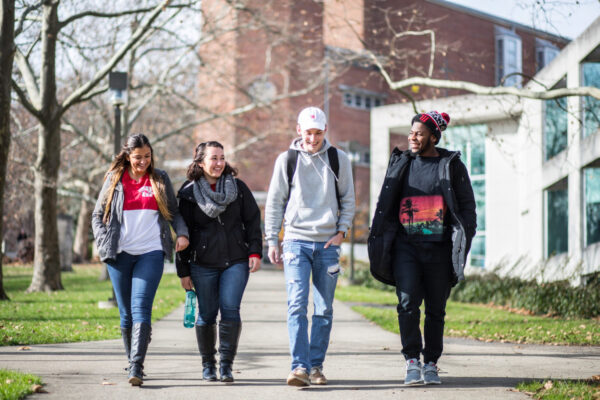This post is the latest in a series on college student mental health and well-being.
On Sept. 21, 2010, Dan Savage launched the suicide prevention campaign “It Gets Better” to reassure queer-spectrum** and trans-spectrum youth that the stigma, bullying, and exclusion they navigate in school and home do not define the possibilities their futures hold.
Just one day after the rollout of this inspiring campaign, Rutgers University freshman Tyler Clementi died by suicide after enduring a combination of cyber-aggression and public humiliation at the hands of his college roommate. Like Tyler, many queer-spectrum and trans-spectrum students continue to navigate stigma, peer aggression, and exclusion well into their college years—experiences that too frequently precipitate symptoms of depression, anxiety, and self-injury.
While institutional research instruments have historically omitted demographic questions capturing the sexual and gender identities of students, limiting our insight into the experiences of these populations, several national research centers have initiated a shift in this landscape by incorporating these items into instruments measuring student experience.
These centers—including the Center for Postsecondary Research at Indiana University; the Higher Education Research Institute at the University of California, Los Angeles; the SERU-AAU Consortium; and the American College Health Association—have partnered with the Tyler Clementi Center at Rutgers University to examine the queer-spectrum and trans-spectrum student responses within their respective datasets.
This analysis, including findings relevant to campus climate, academic engagement, and overall health, spans 918 four-year colleges and universities, representing survey responses from 66,208 queer-spectrum students and 6,976 trans-spectrum students. The most notable findings from this analysis, which are the focus of this blog post, are relevant to disparities in mental health, self-injury, and suicidal ideation.
Cooperative Institutional Research Program’s Freshman Survey
To begin the analysis, we looked at findings from the Cooperative Institutional Research Program’s Freshman Survey, the oldest and largest survey of incoming college freshmen in the nation. Students participate in this survey during the summer before entering college, serving as a baseline for student mental health as they enter higher education.
Given that Tyler Clementi died by suicide only three weeks into his freshman year at Rutgers University, it is critical that higher education professionals anticipate the mental health needs of students entering our doors.
Among the 12,872 queer-spectrum students who completed this survey:
- 36.8 percent reported that they had a psychological disorder, compared to 8.8% of heterosexual students; and
- 35.2 percent reported feeling depressed more than three times that of heterosexual students (10.1 percent).
When asked to self-appraise their emotional health, queer-spectrum and trans-spectrum students revealed dramatically lower scores than their heterosexual and non-transgender peers.
Self-rated Emotional Health (2016 TFS)

These findings are even more troubling when looking at students who self-identified as transgender.
- More than half (52.3 percent) of these students reported having a psychological disorder prior to entering college, compared to just 11.1 percent of non-transgender students.
- They also reported feeling depressed (48.6 percent) at four times the frequency of non-transgender peers (12.1 percent).
- When asked to appraise their emotional health, nearly half (49.6 percent) rated themselves as below average/lowest 10 percent, compared to just 15.8 percent of non-transgender students.
American College Health Association-National College Health Assessment
We also examined the responses of 9,331 queer-spectrum students and 2,294 trans-spectrum students who completed the ACHA-National College Health Assessment (representing 126 four-year institutions). This survey examines mental health in greater depth and revealed several concerning findings:
Among queer-spectrum respondents:
- 23.5 percent had seriously considered suicide in the last 12 months (compared to 8.2 percent of heterosexual peers).
- 18.3 percent had engaged in self-injury (intentionally cutting, bruising, or otherwise injuring themselves) compared to 5.4 percent of heterosexual peers.
- When asked if they had felt “so depressed it was difficult to function” at some point in the past 12 months, queer-spectrum students (59.3 percent) experienced this at almost twice the frequency of heterosexual students (33.7 percent).
Among trans-spectrum students:
- 26.3 percent had seriously considered suicide (compared to 9.9 percent of heterosexual peers).
- 22.0 percent had engaged in self-injury in the last 12 months, compared to 6.9 percent of non-transgender students.
- When asked if they had felt “so depressed it was difficult to function” at some point in the past 12 months, over half of trans-spectrum students (56.2 percent) experienced this compared to 36.7 percent of non-trans-spectrum students.
Spring 2016 ACHA-NCHA Mental Health Findings

Recommendations
While queer-spectrum and trans-spectrum students were more open to counseling/seeking out psychological services than their heterosexual and non-transgender peers (a finding on every survey measuring this attitude), their mental health challenges appear to be far more widespread and serious (in terms of suicidal ideation) than heterosexual and non-transgender peers.
Based on these findings in the data, we make several recommendations to campus administrators:
Develop curricular/co-curricular programming that convenes queer-spectrum and trans-spectrum students and highlights positive aspects of these communities. When connected to other queer-spectrum and trans-spectrum peers, students are more likely to engage in positive identity development—a fundamental protective factor mitigating psychological distress (Bruce, Harper, and Bauermeister 2015; Evans and Broido 2002; Woodford et al. 2014).
Hold events that focus on mental health and wellness in partnership with queer-spectrum and trans-spectrum student organizations that (1) educate students on mental health and wellness, (2) provide concrete strategies for improved self-care, (3) prepare students to support one another, and (4) increase knowledge of mental health resources both on and off campus. Many schools have also found benefit in developing peer mentoring and/or education programs for queer-spectrum and trans-spectrum students.
If possible, create satellite locations for mental health services on campus that provide greater access to queer-spectrum and trans-spectrum students. Multiple campus counseling centers host office hours at LGBTQ campus centers, a strategy that provides clinicians an opportunity to build rapport with queer-spectrum and trans-spectrum students, engender greater trust with students, and increase access and usage of support services. Engaging in more intentional outreach—particularly with first-year students—could perhaps improve mental health over the college lifecycle, reduce academic impediments and disengagement (e.g., skipping class, turning in assignments late, dropping out) caused by depression and anxiety, and most critically, reduce self-harming behaviors (e.g., substance misuse, self-injury, suicide) among queer-spectrum and trans-spectrum students.
Conduct clinically based training with campus mental health professionals related to the unique psychological needs of queer-spectrum and trans-spectrum students. Safe Zone or sensitivity trainings are not sufficient to serve this purpose.
Provide students access to online and passive materials on queer-spectrum and trans-spectrum health and wellness.
Develop policies and practices that affirm queer-spectrum and trans-spectrum students in all facets of campus life: first-year programs, residential life, campus health services, student activities, etc.
Most important of all, add demographic variables measuring sexual identity and gender identity to instruments assessing student experience on campus: enrollment, health, campus climate, student engagement, etc.
Students and institutions may want to consider the following resources:
- The JED Foundation offers a Mental Health Resource Center for Young Adult Emotional Health and Well-being. The site also offers resources for campus counseling centers, care teams, and campus administrators to assist in governing campus protocols and navigating things like FERPA/HIPPA.
- The Trevor Project has a suicide/mental health distress hotline and resources that are specifically for LGBTQ youth.
- Campus Pride is the leading national nonprofit organization for student leaders and campus groups working to create a safer college environment for LGBTQ students. The site also provides a wealth of resources for engaging LGBTQ youth in positive identity development, cultivation of social support networks on campus, leadership development, and mentoring.
To learn more about the findings from this study, please visit the Tyler Clementi Center website to view or download this white paper.
**The terms queer-spectrum and trans-spectrum describe identities that depart from heterosexual and cisgender identities respectively, while honoring that sexual and gender identities are fluid and do not always align with socially constructed, fixed categories commonly conveyed by terms such as “LGBT.”
The Tyler Clementi Center was established in 2013, in memory of the Rutgers University freshman who died by suicide following a series of bias incidents targeting his sexual orientation. The Tyler Clementi Center conducts research on the impact of bias, peer aggression, and campus climate on stigmatized student populations within higher education.
If you have any questions or comments about this blog post, please contact us.



